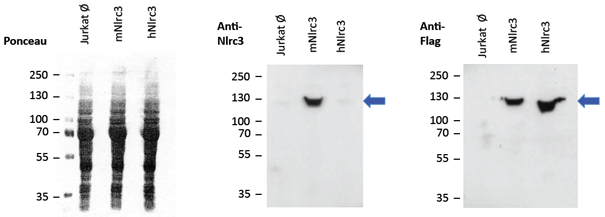
Overexpressed mouse NLRC3 is detected by immunoblotting using anti-NLRC3 (mouse), mAb (Eowyn-1) (Prod. No. AG-20B-0067-C100). Method: Cell lysate protein was loaded and SDS Page was run for 1h at 100V. Transfer for 1h at 80V. Block for 30min
anti-NLRC3 (mouse), mAb (Eowyn-1)
AG-20B-0067
ApplicationsWestern Blot
Product group Antibodies
ReactivityMouse
TargetNlrc3
Overview
- SupplierAdipoGen Life Sciences
- Product Nameanti-NLRC3 (mouse), mAb (Eowyn-1)
- Delivery Days Customer10
- ApplicationsWestern Blot
- CertificationResearch Use Only
- ClonalityMonoclonal
- Clone IDEowyn-1
- Concentration1 mg/ml
- Estimated Purity>95%
- Gene ID268857
- Target nameNlrc3
- Target descriptionNLR family, CARD domain containing 3
- Target synonymsCLR16.2, D230007K08Rik, mFLJ00348, protein NLRC3, caterpillar 16.2
- HostMouse
- IsotypeIgG1
- Scientific DescriptionMonoclonal Antibody. Detects overexpressed mouse NLRC3. Doest not detect human NLRC3. Although NLRC3 (mouse), mAb (Eowyn-1) is strong and specific (see figure), the endogenous protein has not been detected yet with this antibody (using NLRC3 KO versus WT immune cells). NLRC3 protein is probably expressed at very low levels or its translation / stability is triggered by stimuli still to be discovered. Isotype: Mouse IgG1. Clone: Eowyn-1. Applications: WB. Liquid. In PBS containing 10% glycerol and 0.02% sodium azide. The novel nucleotide oligomerization domain (NOD)-like receptor (NLR) with a caspase activation and recruitment domain (CARD) 3 (NLRC3) protein belongs to the NLR family of cytosolic pathogen recognition receptors. NLRC3 has the characteristic NOD and leucine-rich repeat configuration with a less well defined CARD. NLRC3 is expressed in T lymphocytes and may be involved in suppression of T cell activation. NLRC3 is a cytoplasmic protein that negatively regulates pro-IL-1beta maturation and inhibits toll-like receptor (TLR)-dependent activation of the transcription factor NF-kappaB. NLRC3 interacts with the TLR signaling adaptor TRAF6 to attenuate Lys63 (K63)-linked ubiquitination of TRAF6 and activation of NF-kappaB. NLRC3 also reduces STING-dependent innate immune activation in response to cytosolic DNA, cyclic di-GMP (c-di-GMP) and DNA viruses. NLRC3 associated with both STING and TBK1, impedes STING-TBK1 interaction and downstream type I interferon production. - The novel nucleotide oligomerization domain (NOD)-like receptor (NLR) with a caspase activation and recruitment domain (CARD) 3 (NLRC3) protein belongs to the NLR family of cytosolic pathogen recognition receptors. NLRC3 has the characteristic NOD and leucine-rich repeat configuration with a less well defined CARD. NLRC3 is expressed in T lymphocytes and may be involved in suppression of T cell activation. NLRC3 is a cytoplasmic protein that negatively regulates pro-IL-1beta maturation and inhibits toll-like receptor (TLR)-dependent activation of the transcription factor NF-kappaB. NLRC3 interacts with the TLR signaling adaptor TRAF6 to attenuate Lys63 (K63)-linked ubiquitination of TRAF6 and activation of NF-kappaB. NLRC3 also reduces STING-dependent innate immune activation in response to cytosolic DNA, cyclic di-GMP (c-di-GMP) and DNA viruses. NLRC3 associated with both STING and TBK1, impedes STING-TBK1 interaction and downstream type I interferon production.
- ReactivityMouse
- Storage Instruction-20°C,2°C to 8°C
- UNSPSC12352203
